Menu
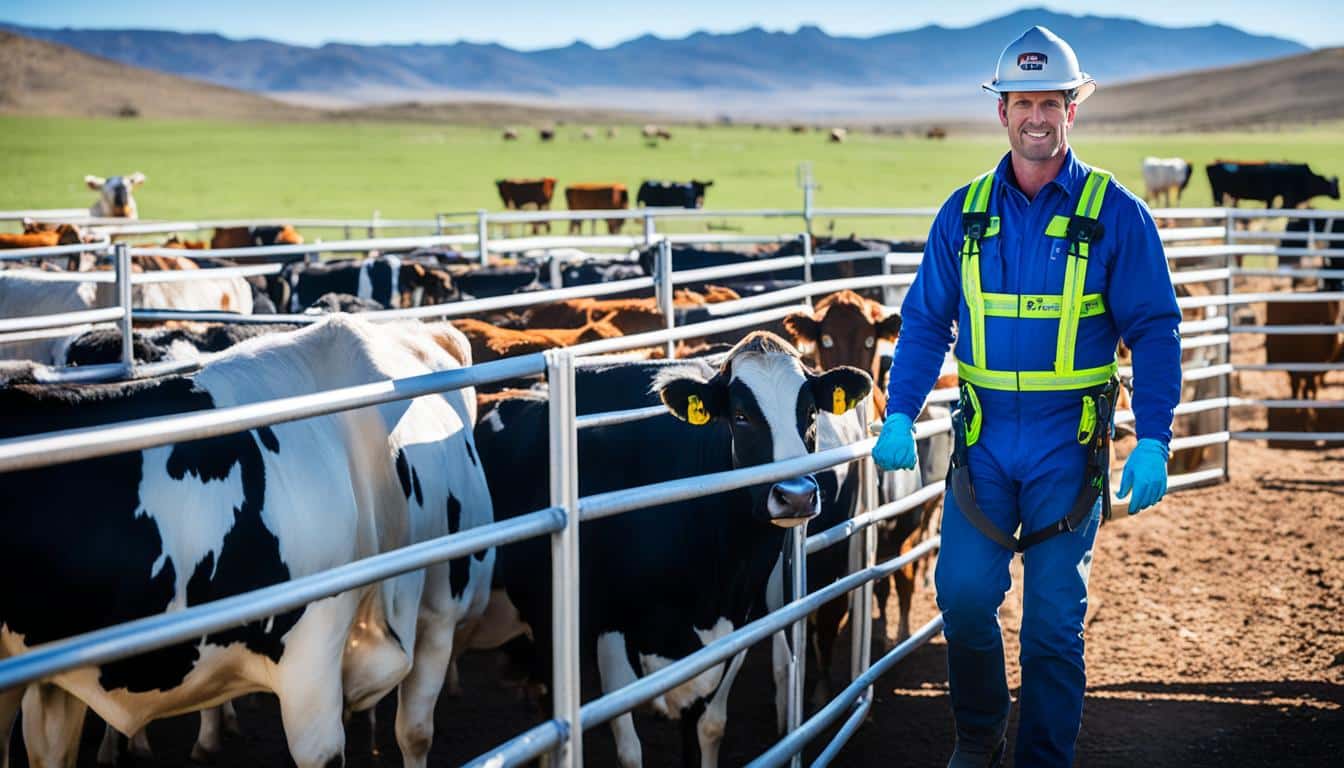
Did you know that many farm injuries involve livestock? Stats from Purdue University and the National Agricultural Safety Database show this. One in six and one in three farm injuries come from animals. So, are our livestock handling safety measures good enough?
Handling livestock can lead to injuries like being stepped on, knocked down, or bitten. These are common and show we need better safety measures. Dr. Temple Grandin says using safe methods not only avoids injuries but makes better products too. For example, gentle handling stops meat from becoming bruised and of lower quality.
Animals can see all around them, making them jumpy if something moves too fast behind. They also hear high sounds we can’t, which can make them nervous. Knowing this helps keep handling them safe.
It’s clear that proper livestock handling safety is crucial. This includes using good agricultural handling practices and being smart about how we handle animals.
Animal welfare and farm safety are top priorities for those around livestock. Even with safer farm machines, accidents involving animals still happen a lot. The National Safety Council notes that beef cattle and dairy farms see a lot of injuries. This makes taking care of livestock really important.
When working with animals, it’s important to know their behaviours. You should watch for signs that an animal might get aggressive. It’s key to remember that most incidents are not deadly but can still cause harm. Injuries might happen from bites, kicks, or being pushed by animals. For example, bulls cause more than half of all livestock-related injuries and deaths. This shows why safe handling is crucial.
It’s critical that those working with animals know about safety guidelines. The OSU CFAES program has a lot of resources on safe livestock handling. They teach things like moving calmly around animals and using the right protective gear. These steps help keep farms safe and lower the chance of getting hurt.
The way livestock facilities are set up affects safety too. Good floors, drainage, and fences are key. So is having the right lighting. Injuries can happen when barns or pens are not kept in good shape. This is why maintenance is so important.
It’s vital to know about how animals behave to handle them safely. For example, cattle can see widely but not right behind them. This makes handling them from behind risky. Loud noises can also stress animals. Maintaining a routine for how you feed and handle them helps. And remember, livestock are strong. Their size and power make careful handling a must.
When you work with livestock, understanding their perception and reactions is key. Knowing the signs of fear and aggression is crucial. It keeps both the animals and workers safe. This knowledge is also vital for good animal care.
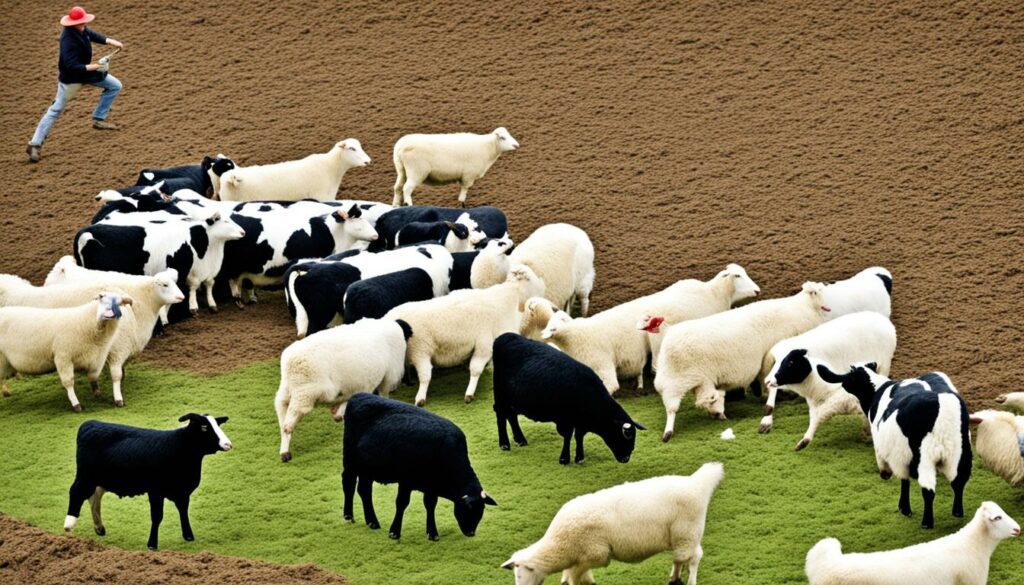
To handle livestock well, you must spot when they are scared or mad. They might show this by their ears, how they stand, or by snorting. Knowing these signs helps you work with them without getting hurt. It also makes their surroundings feel safer, which is important for their wellbeing.
Animals see and feel things differently than people. They have wide vision and are scared of sudden movements. Some colours like yellowish-green can make them uneasy, and they are great at seeing shadows. For their comfort, it’s best to avoid things that startle them.
When animals are moved or held, it can make them sick. This means handling them gently is a must. Making their space calm and well-lit lowers their stress. Livestock that’s used to kind handling are happier and easier to work with. These gentle approaches make a big difference.
Working with livestock is risky because animals are unpredictable. But, there are ways to make it safer. It’s important to know some safety tips. These can help lower the chances of getting hurt. For starters, avoid sudden moves and loud sounds. These can scare animals. Scared animals may become aggressive. So, be slow and steady. Stick to a simple and calm routine when you interact with them.
Gently touching animals can calm them. This makes handling easier for both the animals and you. And it helps cut down on accidents. A study by Teagasc found that 65% of farm injuries come from dealing with animals. It’s key to avoid injuries from squeezing, kicking, or headbutting. This is very serious. There are a lot of reports about people dying because of bulls attacking.
Keeping the area where livestock are handled secure is crucial. Make sure kids stay away. Their presence can make accidents more likely. Having an easy way to get out is very important for your safety. This is especially true when moving animals. Take care. Many bad accidents happen then. Planning these tasks well is a must. Do them with great care.
Good facilities make a big difference in safety.Poorly designed places can lead to more accidents. This is true when herding or moving animals. Investing in good places for bulls and for loading animals is smart. It makes things safer. This way, there’s less risk of getting crushed or hurt by animals.
Making use of good practices also helps. For small animals like sheep, use the right gates or crates. And for pigs, use good ways to keep them in place. Always check your tools and equipment. Make sure they are safe and work well.
Knowing how animals act is also very important. Cows can get really aggressive when they have babies. They can be a big danger. Training bulls to see people in a friendly way can stop bad behaviour. Feed them and groom them to show they are safe and friendly. This can help avoid injuries.
“Good husbandry practices can help prevent health issues and injuries related to livestock handling.”
So, following these safety tips doesn’t just keep you safe. It creates a happy and productive farm for everyone.
Making sure farms are safe with detailed plans for livestock buildings boosts both work quality and animal welfare. A smart layout reduces stress and injuries, and it helps with farm work as well.
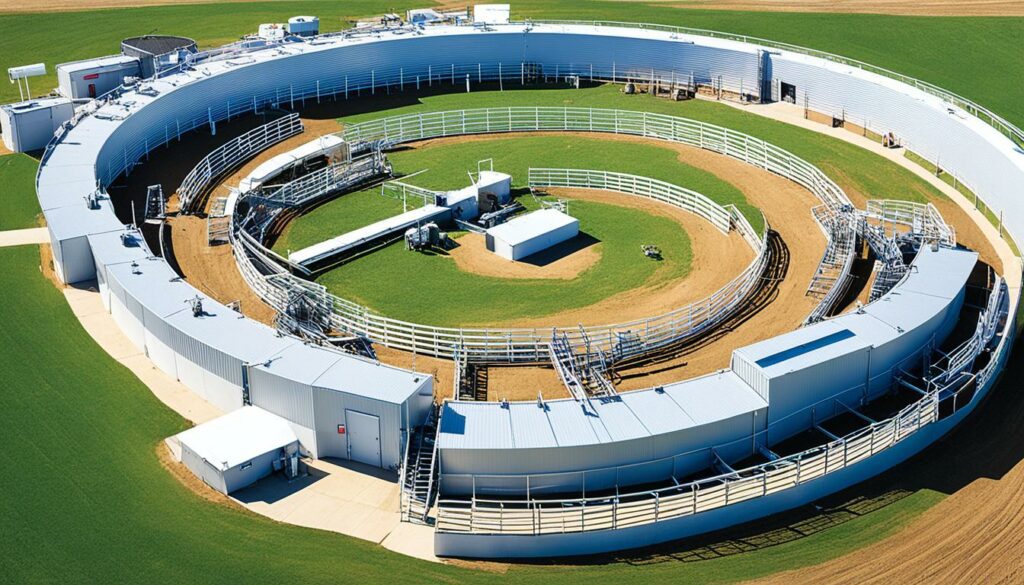
For floors, go with rough concrete. It stops animals from slipping. Adding grooves or rubber where they walk a lot makes it even safer. This gives animals a stable surface and helps prevent injuries.
Use strong fences to keep animals safe. They help create a calm path for moving animals, which lowers their stress. It’s key that the area is well-lit and free from shadows, preventing scare for a smoother movement.
Enough light in barns is crucial. It gets rid of dark spots that could scare animals. Lights should be placed smartly, so animals move easily. This design not only keeps the farm safe but also makes work easier.
Making sure livestock stay healthy and safe is all about cleanliness. It keeps the animals and the people working with them well. A clean area, good air flow, and careful feeding are key.
A tidy and dry place is crucial for looking after animals. It keeps the herd healthy and safe and reduces disease risks. By cleaning often, you can get rid of most germs. This makes disinfection more effective.
Good air flow is vital for keeping livestock safe. It lessens the amount of harmful germs and gases in the air. Lowering dust with proper ventilation can help avoid breathing and health problems.
Making sure animal feed is clean is important. Buying feed from trustworthy sources reduces contamination risks. Dirty feed can cause breathing and stomach problems in animals. This affects how well they can work or grow.
Remember, good hygiene practices are key for a safe farm. Clean everything well, make sure the air is fresh, and watch the food. This helps keep the animals and handlers safe and sound.
| Risk Factor | Consequences |
|---|---|
| Unclean Environment | Increased disease risk, pest infestation |
| Poor Ventilation | Respiratory problems, high ammonia levels |
| Contaminated Feed | Digestive issues, toxin exposure |
| High-Frequency Sounds | Skittish, stressed animals |
| Accidents | Injuries from animal or machinery |
| Zoonotic Diseases | Brucellosis, Salmonella, Trichinosis |
Ensuring livestock handling safety means investing in the right equipment for each type of animal. This gear makes working with animals easier, lessens the need for hard labour, saves money, and lowers injury risks. Studies show that many farm injuries come from working with animals. So, it’s vital to pick the best tools.
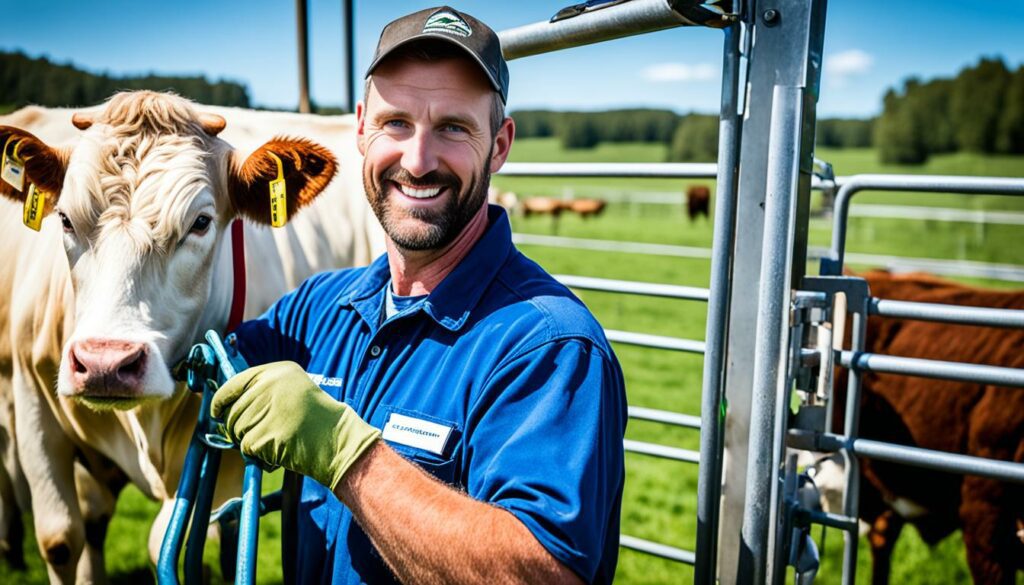
At Ohio State University Extension, Richard Purdin points out that clean, well-lit ramps and trailers stop animals from getting scared or hurt. It’s key to keep these areas tidy and bright for safe agricultural handling practices.
Looking closely at this advice, it’s clear that choosing the right gear is a big step towards farm safety. Farmers and workers need to keep updating their tools to the latest safety and animal care rules.
Working in tight spaces with livestock comes with challenges for safety. A big danger is the gas that builds up from manure. This gas includes hydrogen sulfide, ammonia, carbon dioxide, and methane. They can harm people and animals, especially in places without enough air. This can even lead to death.
It’s key to have the right building and vents to avoid these dangers. Good ventilation is vital. It not only cleans the air but also makes the farm safer by stopping gas from getting too high. Also, keeping up with the care of the ventilation system is important for safety.
But it’s not just about fresh air. It’s important to keep these areas clean to stop diseases from spreading. By cleaning and disinfecting often, you can keep sickness away from livestock and people.
Following these steps helps make working with confined livestock less risky. Doing these things is really important for keeping the farm safe. It’s essential for good livestock handling safety.
Staying safe around livestock is very important. A recent study by the National Safety Council found that on farms, beef cattle come second and dairy operations are third for injuries. This shows how critical it is to focus on health and safety. Interestingly, about seventeen percent of farm injuries involve animals. This is the same as injuries from farm machinery.
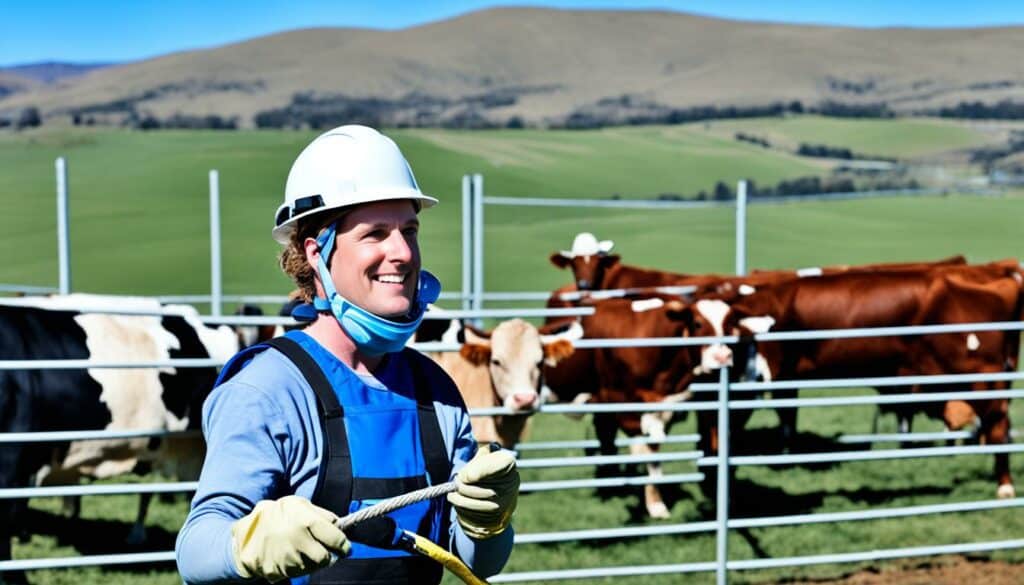
Things like high door sills, messy alleyways, and bumpy floors can lead to bad falls. Such falls not only cause injuries but also lead to a lot of missed work. It’s key to spot and lessen these dangers. And be aware, animals can get nervous in dark or bright areas, making it more important to handle them with care.
Knowing how animals act and the right way to handle them is very important for safety. Some people face more risk, like those new to farming, older farmers, or when dealing with certain animals. It’s vital to keep these risks in mind for everyone’s safety.
Knowing the farm setup well and keeping escape routes clear is crucial to avoid big problems if animals get loose. Planning ahead and handling animals gently cuts down on danger. The guide points out the signs to look for in animal behaviour and the need to keep facilities in good shape.
and
are diseases that can spread in farm settings. Lyme Disease (LD) can show up 2 to 30 days after a tick bite. It’s treatable with antibiotics but can become serious if not treated. Brucellosis (Bangs Disease) affects cattle, goats, and pigs and can get passed through milk or infected animals.
Bulls are known to be particularly dangerous, causing accidents each year. Because of this risk, it’s vital to always wear the right safety equipment and follow guidelines for handling livestock.
Training and education are vital for managing livestock and ensuring farm safety. Surprisingly, just 60% of U.S. dairy farms train their staff. Of those, only 12% use interactive methods like videos in their training.
Mixing oral talks with practical demos increases employee knowledge by 21% to 23.7%. Programmes focusing on milking, calving, and hoof care can raise knowledge by 29.42%. This not only helps in managing animals better but is also key for safety on the farm.
For instance, after training, milk yield goes up by 4 lbs per cow daily. There are fewer stillborn calves and less issues like retained placenta. Plus, cows facing these problems have better chances of getting pregnant.
The Food Safety Modernization Act (FSMA) says farm workers need food safety training. They must learn about safe handling of food and keep up with guidelines. This helps make sure the food we eat is safe. The training is available in English and Spanish, showing everyone can learn to keep food safe.
Penn State Extension provides many educational tools, like booklets and videos. They teach about farm safety and compliance with regulations. This helps keep food safe and farmers informed about the latest rules.
With these figures in mind, it’s clear that good training is a must for top-notch farm and livestock care. We need to keep creating and sharing useful training to keep farms safe and efficient.
Creating an effective livestock handling routine is key for safety and efficiency. It makes the farm a predictable place for animals. This way, they know what to expect and are less stressed. It also helps those working with the animals have an easier time.
Some key points to keep in mind are:
Research by the National Safety Council shows that working with beef cattle and dairy cows can be risky. These farms are second for injuries, followed closely by dairy. A big part of these accidents involves how we handle the animals. This shows why organised and safe practices are so vital.
Failing to handle livestock safely can lead to falls and other accidents. We need to design our working areas so they are safe for both people and animals. A big part of this is making sure the air is clean and safe. Remember, good handling practices help everyone, even economically.

A good livestock handling routine helps avoid dangers like toxic gas from manure pits. Things like hydrogen sulfide can be very harmful. Making sure there’s enough fresh air and keeping everything clean are crucial steps. Also, important are proper training, equipment care, and setting up the environment the right way. They all make working with livestock safer and better for everyone involved.
Wearing the right gear is critical in staying safe while working with livestock. If you wear the right protective gear, you can prevent both injuries and diseases. This makes the work safer for you and the animals. I’ll tell you about the most important protective gear for anyone working with livestock.
Head protection is key, especially in low buildings or when you’re fixing machines. Hard hats keep you safe from head injuries, which are common in this job. They’re a must-have for anyone working with animals.
Protect your feet with steel-toed or hard-toed shoes. Livestock can step on you, so these shoes help prevent foot injuries. Animals are heavy and can move suddenly, making it crucial to protect your feet.
It’s important to have good ventilation to stop dust from causing health problems. Dust masks should be worn in dusty areas without good air flow. They help keep you safe by stopping you from breathing in too much dust.
When you work with chemicals, use rubber gloves, splash goggles, and a respirator. They protect you from getting the chemicals on your skin or breathing them in. You should also wear protective clothes made of special materials to avoid skin contact with chemicals.
Eyes and hands must be protected when dealing with sick animals or giving them medicine. Doing this helps stop the spread of disease, protecting both you and the animals.
Always check your gear, like your shoes, and follow safety rules closely. This keeps the workplace safe. Safety is everyone’s responsibility in a livestock environment.
| Protective Gear | Usage | Benefit |
|---|---|---|
| Hard Hats | Low ceilings, machinery repair, off-road vehicles | Prevents head injuries |
| Steel-toed Shoes | General livestock handling | Prevents foot injuries |
| Dust Masks | Areas with inadequate ventilation | Reduces dust exposure |
| Rubber Gloves | Chemical handling | Avoids chemical skin absorption |
| Splash Goggles | When using pesticides | Prevents eye exposure to chemicals |
| Respirators | Chemical and dust exposure | Protects respiratory health |
| Protective Clothing | Handling chemicals | Prevents skin absorption of chemicals |
| Safety Glasses | Handling sick animals | Prevents disease transmission to eyes |
Every year, many people get hurt because they don’t understand how to be safe with livestock. You can avoid broken bones, hurt limbs, missing work, and unnecessary medical bills by using the right gear and being careful. This way, you make sure the work environment is safe for you and the animals.
The world of livestock is varied. Each type, like cattle, pigs or horses, needs its own way of being handled. Knowing how to work with them, their habits, and what they require, is key for everyone’s safety and health.
Cattle have a unique skill – nearly 360° vision. But this can make them jumpy. They may react quickly to things behind them. For example, on beef farms, injuries are the second highest, and on dairy farms they’re third. About 17% of farm injuries come from animals.
Falls cause 18% of these injuries. So, it’s vital to create safe spaces and always be alert when working with cattle.
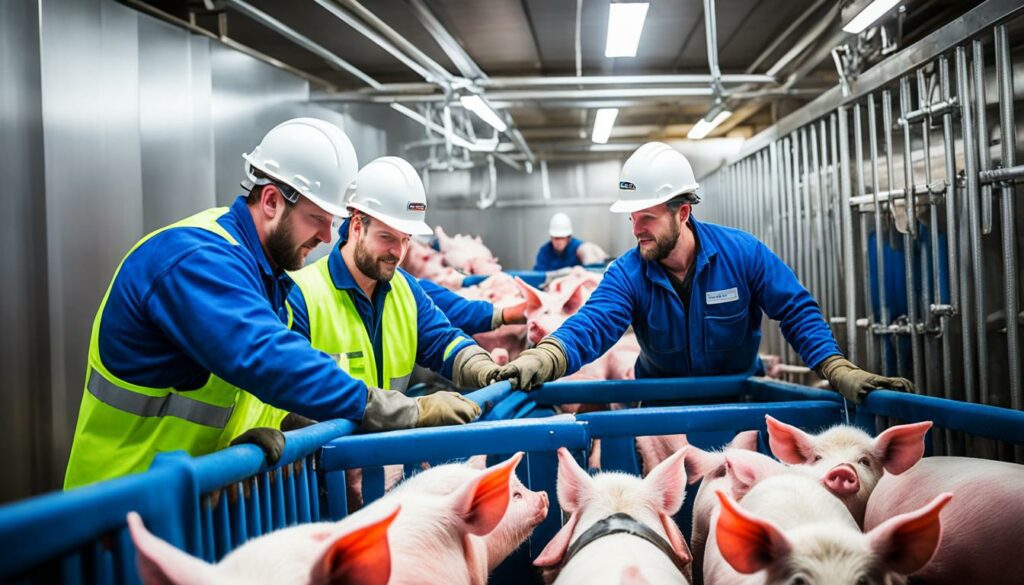
Horses can react strongly when they’re scared, often showing this through their actions. Signs like ears up, teeth showing, and a tense walk, all indicate they’re not comfortable.
Research from Dr. Temple Grandin shows loud noises can set horses off. A calm environment is key for working with horses. This not only keeps handlers safe but also ensures the horses stay well.
| Livestock Type | Common Handling Issues | Preventive Measures |
|---|---|---|
| Cattle | Spooking due to panoramic vision | Move calmly, avoid rapid movements |
| Pigs | Poor depth perception | Slow, deliberate movements; good ventilation |
| Horses | Reaction to loud noises | Maintain a quiet environment, recognise signs of fear |
It’s crucial to reduce the risk of zoonotic diseases for overall livestock handling safety. This means setting up strong hygiene rules and sticking to immunisation guidelines. Doing this can greatly lower the chance of disease transmission.
From 1996 to 2010, over 150 outbreaks of diseases humans can catch from animals happened. Zoonotic diseases like anthrax and rabies show why we need good biosecurity. Summer and autumn see more STEC and Salmonella around, when fairs and animal shows are common. This raises the disease transmission risk.
Things like stress, being in tight spaces, and lots of people around can make animals spread diseases more. Children, who love these events, are more at risk of getting really sick if infected. So, it’s vital to keep places clean to protect everyone.
Focusing on hygiene and vaccines is key in stopping zoonotic diseases. After the 2000 E. coli outbreaks, the CDC stressed the need for these steps. Keeping areas clean, well-ventilated, and having places to wash hands helps a lot.
Good biosecurity is not just about cleaning. It’s also about controlling who comes to the farm and keeping things neat. It’s important to clean and disinfect vehicles and work areas. Immunisation is just as vital; vaccinating animals lowers the disease risk for people, as seen in Western Greece.
| Factors Increasing Disease Risk | Measures to Mitigate Risk |
|---|---|
| Stress from transportation and confinement | Implement stress-reduction techniques and minimise confinement |
| Inadequate hand-washing facilities | Ensure readily accessible hand-washing stations |
| Inappropriate visitor flow | Plan visitor routes to avoid cross-contamination |
| Improper animal and human interaction | Train staff and visitors on proper hygiene and handling practices |
By using these steps and understanding how zoonotic diseases spread, both animals and humans can stay healthy on farms. Committing to top-notch hygiene and safety rules creates a better place for everyone.
Emergencies can happen fast on farms. So, preparing is key for a good response. Make full plans and teach first aid. This can really help in animal emergencies. Know what you need and do for different problems.
For instance, the AVMA says to keep a Livestock Evacuation Kit. This kit should have food, water, medicine, and records.
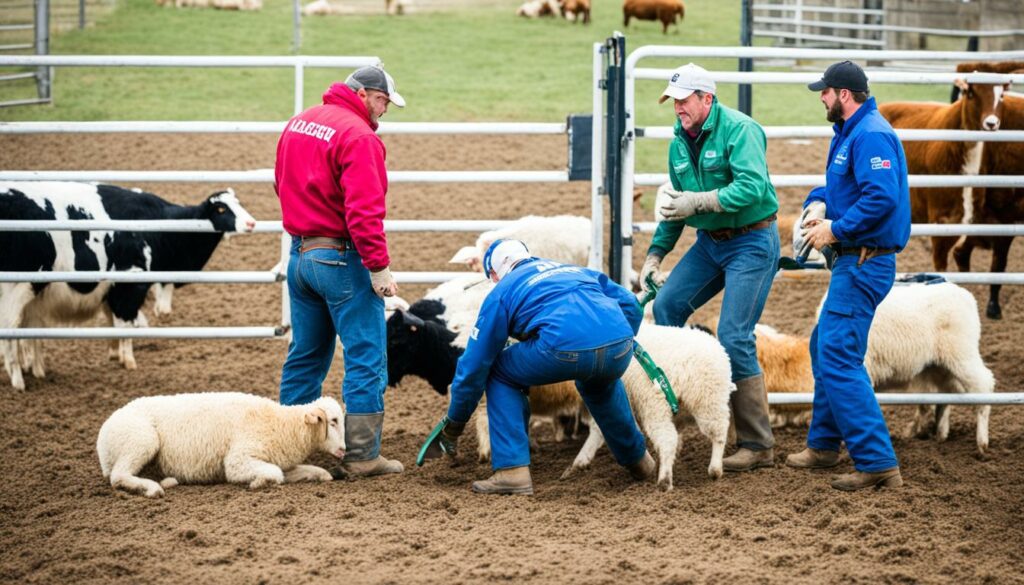
The USDA says being ready for bad weather is crucial. Have a plan to move your animals and where to take them. Also, ensure they have proper shelter, enough food and water, and warm bedding.
Doing safety checks on your farm is essential, especially for severe weather.Knowing what to do with each animal is vital. This includes making sure they’re identified. Have a neighbour ready to help look after your animals too.
Learning first aid is very important for animal care. Fast and smart help can save lives. You should know how to clean wounds, control bleeding, and spot common injuries.
The NAHERC helps with diseases and other big problems. Keep your animal’s health records and medicines near. This makes your response faster during tough times.
Good communication and following local rules are also key. They help keep your animals safe during emergencies.
Checking and improving how we handle livestock is crucial. It helps us see where we can do better and make things safer. A study by The National Safety Council highlights the importance. It shows that working with beef cattle and on dairy farms leads to more injuries.
Farm accidents are a big deal, especially those involving animals. Focusing on making handling better, like having rough floors to avoid slips, is key. It was found that 18 percent of animal-related accidents come from people falling. This makes having safe paths very important.
Besides safety, checking on things regularly helps us keep up with the latest. For example, making sure there’s enough air flow can stop dangerous gases from building up. These gases, like hydrogen sulfide and methane, can be very harmful. So, looking out for dangers like these is really important.
| Hazard | Prevention |
|---|---|
| Animal-Related Injuries (17%) | Continuous training on gentle handling techniques, understanding the flight zone, and proper use of equipment |
| Falls (18%) | Maintaining roughened and grooved concrete floors in high traffic areas |
| Toxic Gas Exposure | Ensuring proper ventilation during waste agitation |
Having a good system in place for checking and improving livestock care does a lot. It makes things safer. Plus, it means we’re always using the best methods. This way, farms become safer and better places to work.
It’s crucial to use livestock handling safety methods. They protect both animals and the people working with them. Knowing how animals behave is key. Cattle, for example, can see all around them except for a spot right behind. So, it’s vital to stay in front or at their side to stay safe.
Bulls cause more than half of the serious injuries and deaths linked to livestock. This means extra care is needed when around them. It’s important to be patient and keep quiet. This prevents them from getting scared. Remember that cattle and hogs find it hard to see distances. They only see in black and white, not in colour.
Building safe facilities is very important. These should have floors made of grooved concrete, good drainage, and strong fences. Such buildings lower the risk of accidents. Also, training and staying updated on safety are crucial. This includes learning about animal care, dealing with emergencies, and wearing the right protective gear.
By taking these steps seriously, we make farm work safer and more efficient. It’s vital to always look for ways to do things even better. This way, we can make farming not only safer but also more successful. Let’s always focus on keeping people and animals safe by sticking to these guidelines.
Avoid quick movements and loud noises when with livestock. It helps protect you and the animals. Establish a slow, careful routine to handle them. Always have a clear way out in case of emergency. Having well-designed facilities is also key to reducing risks.
Livestock safety is vital for everyone’s well-being. It prevents injuries and encourages good animal care. This leads to safer farms and better productivity.
Knowing how animals act and what they fear is key. Handlers can then avoid dangerous situations. This makes working with livestock a lot safer.
To keep safe, avoid sudden moves and keep the area calm. Make sure kids stay clear of livestock. Always have a way out, just in case.
Sturdy flooring like rough concrete is a must. Fencing and gates should be secure. Ample, good lighting is needed to prevent shadows. Well-structured alleys and chutes aid in safe handling.
Keep the environment clean and well-ventilated. Regularly check feed for harmful substances. Dry facilities and clean practices help prevent health issues.
Safe tools reduce work and injury risks. The right equipment for each animal makes handling efficient and safe.
It’s important to design buildings with good ventilation. This stops toxic gases building up. Knowing the hazards helps keep confinement handling safe.
Know animal behaviour and safe handling. Use protective gear suitable for the job. Be mindful of facility layouts to always have an escape planned.
Learning how to handle livestock and about animal behaviour is vital. So is knowing what to do in emergencies. Ongoing education improves animal care and safety.
A regular, known routine calms livestock and cuts down on surprises. Less stress lowers the risk of accidents, making handling safer.
Gloves, boots, helmets, and safety glasses are all important. They defend against different dangers, making handling safer for everyone.
Yes, handling varies for different animals. Knowing their behaviours and needs prevents injuries and lifts animal welfare.
Keep facilities clean and follow immunisation protocols. Proper handling is also crucial. Knowing about and avoiding zoonotic diseases keeps everyone safe.
Always be prepared for emergencies with a plan. Know how to provide first aid. Quick and effective responses can save lives.
By keeping an eye on safety and updating methods, we avoid incidents. Staying current on safety measures makes for a better and safer farm.